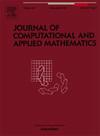线性不适定问题随机重球法的收敛性分析
IF 2.1
2区 数学
Q1 MATHEMATICS, APPLIED
Journal of Computational and Applied Mathematics
Pub Date : 2025-04-21
DOI:10.1016/j.cam.2025.116702
引用次数: 0
摘要
本文研究求解线性不适定逆问题的随机重球法。在适当选择步长和动量系数的情况下,建立了该方法在先验选择停止指标下的正则化性质,并推导了在基准源条件下所求解的收敛速度。数值结果验证了该方法的性能。本文章由计算机程序翻译,如有差异,请以英文原文为准。
Convergence analysis of a stochastic heavy-ball method for linear ill-posed problems
In this paper we consider a stochastic heavy-ball method for solving linear ill-posed inverse problems. With suitable choices of the step-sizes and the momentum coefficients, we establish the regularization property of the method under a priori selection of the stopping index and derive the rate of convergence under a benchmark source condition on the sought solution. Numerical results are provided to test the performance of the method.
求助全文
通过发布文献求助,成功后即可免费获取论文全文。
去求助
来源期刊
CiteScore
5.40
自引率
4.20%
发文量
437
审稿时长
3.0 months
期刊介绍:
The Journal of Computational and Applied Mathematics publishes original papers of high scientific value in all areas of computational and applied mathematics. The main interest of the Journal is in papers that describe and analyze new computational techniques for solving scientific or engineering problems. Also the improved analysis, including the effectiveness and applicability, of existing methods and algorithms is of importance. The computational efficiency (e.g. the convergence, stability, accuracy, ...) should be proved and illustrated by nontrivial numerical examples. Papers describing only variants of existing methods, without adding significant new computational properties are not of interest.
The audience consists of: applied mathematicians, numerical analysts, computational scientists and engineers.

 求助内容:
求助内容: 应助结果提醒方式:
应助结果提醒方式:


